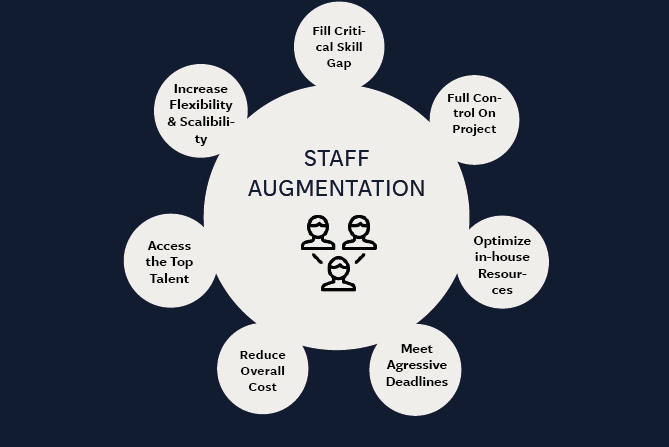Table of contents
- All hands on deck – options to scale a team
- Hire new staff: good old employment?
- Outsourcing: people and processes at an external provider
- Staff augmentation to scale a team
- What do you need to know about the staff augmentation model?
- Benefits of staff augmentation services
- Checklist for building a successful augmented team
- Try NoA Ignite’s staff augmentation services
There are two established approaches to growing an IT or marketing team – hiring and outsourcing. Sometimes however, neither of these models does the trick. Luckily, there’s a third model that offers the best of both worlds: staff augmentation.
All hands on deck – options to scale a team
Sooner or later, every rapidly growing organisation will face a challenge – the in-house team is no longer sufficient. Projects keep piling up, deadlines are at your heels, and staff can’t keep up. In this situation, there are two common HR models:
- Hire new staff
- Work with an external agency or a software house (outsourcing)
In this article, we’ll introduce a third option, which is to augment the in-house team. But first, let’s briefly look at the two established approaches.
Hire new staff: good old employment?
For many companies, hiring a new team member is the most obvious choice. But even though it may seem like the most logical option, the process comes with several challenges:
- It can be both time-consuming and expensive to find a qualified expert. The IT world struggles with workforce shortages, in particular mid- and senior-level specialists and engineers[1]. The reality is that there are hundreds of thousands of unfilled IT positions.
- The recruitment process, especially running interviews, can distract your team. Instead of focusing on the new project, they get involved trying to find a worthy candidate.
- If you’re looking for temporary support (for example a specific project), hiring a new employee is inefficient.
So, perhaps you should think about outsourcing instead?
Outsourcing: people and processes at an external provider
In many cases, this model is effective, flexible and profitable for both parties. It’s not flawless, though. Finding and establishing a fruitful cooperation with an external company can take time. After all, the agency has their own office, and their employees work for many clients. They will need some time to familiarise themselves with your business and the project. If you’re running on a tight schedule, this onboarding process can be a deal-breaker.
Thankfully, our third suggestion allows you to overcome these obstacles.
Staff augmentation to scale a team
As we mentioned in the introduction, we believe that staff augmentation offers the best of both worlds. With this HR model, you get a mix of full-time employment and outsourcing, which facilitates team scaling. In other words, you can extend your team’s capabilities by getting dedicated specialists (developers, testers, engineers, consultants) who work just for your company, along with your team.
Such interim specialists can be hired on a short-term or long-term contract basis, but without the liabilities of regular employees.
What do you need to know about the staff augmentation model?
Staff augmentation is a blend of full-time employment and outsourcing, which makes it a very effective model, and flexible, too! You can hire just one specialist or an entire dedicated development team. These experts work side by side with your in-house employees, enhancing their capabilities.
In this model, the interim specialists that land in your office are hired by an external company, typically a software house or a marketing agency. This entity is responsible for:
- Employment and payroll
- Taxes
- Health and safety
- Sick leave and vacation
The external company takes all these responsibilities and formalities off your shoulders. Now, let’s take a closer look at the pros and cons of this hiring model:
Benefits of staff augmentation services
- You’re still in charge: Although you’re not technically the employer, you work closely with the company hiring those specialists. This enables you to set the ground rules. Working with experienced specialists, you manage their work and remain in charge of all the processes.
- Time and money savings: There’s no need to go through the time-consuming recruitment process or worry about HR, payroll, accounting, administration, taxes, etc. You don’t even have to pay the salaries.
- Flexibility: Your company can hire exactly the specialists you need, regardless of their experience (junior, mid, senior) or area of expertise. This way, you can quickly assemble a team that ticks all the right boxes.
- Transparency: There are no hidden costs. You just pay for the time of your new team.
This model is more flexible than full-time employment and quicker than typical outsourcing. Just be aware that there are still some challenges along the way, especially in the beginning. You have to establish rules and requirements around communication, workflow and other processes, for example.
You also need to make sure that the new team is a good match for your company. To help you with this, we have created a checklist.
Checklist for building a successful augmented team
- Define your needs: Build a common understanding of your needs and goals, and look for a company that can provide a tailor-made solution.
- Match your organisation’s culture and values: Pay attention to the external company’s style of collaboration, ability to process feedback, willingness to learn and their flexibility and proactivity in cooperation. For example, ask your potential partner how they choose their team members or support their growth. You can also try to find out if your interim team members have worked in a setup similar to yours.
- Review team members’ portfolios and client testimonials: Don’t hesitate to ask for client testimonials and the team members’ portfolios. Feel free to consult their previous clients. Were they satisfied with the service? Was the project successful? What worked well and what didn’t? These are crucial questions, and you need the answers before you sign the dotted line.
- Be clear about your productivity goals and success criteria, including how to monitor them: For instance, you could ask your partner how they measure and ensure quality on a day-to-day basis. If you have a ready-made list of such requirements or measurements, it’s a good idea share it with your partner. This way, you stay transparent from square one.
- Make sure the setup is flexible in case your needs change: This point is critical, especially when you’re looking for a long-term collaboration. Your needs can (and most likely will) change over time. Make sure that your agreement takes such changes into account and provides means and tools to adjust the cooperation.
- Run your own interviews and focus on people rather than vendors: At the end of the day, you work with people, not a company. Set at least one short meeting with every team member. If there’s chemistry between you, successful cooperation is in sight!
- Prepare onboarding and work procedures: This way, your new team members will be able to get acquainted with the project effectively. At NoA Ignite, we believe that explaining why people should do something (not just what they have to do) results in better commitment, more creative ideas, and – in effect – better results overall.
Try NoA Ignite’s staff augmentation services
If you think staff augmentation would work for you, we encourage you to test our team. At NoA Ignite, we are used to working with clients off and on-site and have plenty of experience with staff augmentation services. Our team consists of highly skilled, versatile specialists who will gladly support you with everything related to digital services and products. We are particularly experienced with DXP platforms, large scale web applications and e-commerce.
Drop us a line today, and find out what we can do for you!
Author

Katarzyna Juszczyk
Front-End Developer
Katarzyna Juszczyk is a Front-End Developer with a passion for experimenting, knowing-it-all and encouraging others to share her excitement. She’s been a part of many initiatives promoting Front-End technologies. When she’s not doing Front-End, she’s most likely all about horses or art or horses in art.
Related articles
![image of blured woman walking in the office]()
April 29, 2024 / 3 min read
Mobbing is on the rise; here’s how we prevent it at NoA
What we thought unthinkable in today’s workplace which is increasingly focused on equality, diversity, and social inclusion – is happening. We are talking about the rise of mobbing.
![NoA Ignite's team on Poland Business Run]()
January 4, 2024 / 2 min read
Sharing is caring: NoA’s 2023 CSR initiatives
As the year comes to an end, we all naturally reflect on it. We ask ourselves, "What good have I done this year?" At NoA, we're no different. Let's take a look at some of the...




